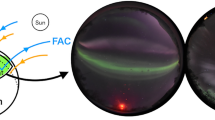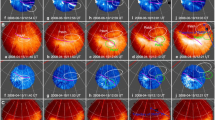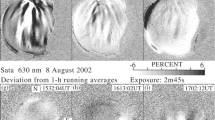Abstract
Polar cap airglow patches have been known as regions of enhanced 630.0 nm airglow detected by ground-based all-sky imagers at the polar cap latitudes well inside the main auroral oval. Although they were already recognized almost four decades ago as counterparts of polar cap (plasma density) patches, such airglow observations had not been utilized extensively for the studies of ionospheric structures and/or magnetosphere-ionosphere coupling processes in the polar cap. In the last two decades, following the development of highly-sensitive airglow imagers equipped with cooled CCD (Charge Coupled Device) cameras, it has become possible to visualize the dynamical temporal evolution and complicated spatial structure of airglow patches with improved signal-to-noise ratio. Such a progress has enabled us not only to use airglow patches as tracers for plasma convection in the polar cap but also to understand the generation of small-scale plasma irregularities in the ionospheric F region. In addition, recent observations demonstrated a case in which an airglow patch was accompanied by an intense flow channel and corresponding field-aligned current structure along its edges. This implies that airglow patches can signify magnetosphere-ionosphere coupling process in the region of open field lines at the polar cap latitudes, serving as a remote sensing tool just like auroras do. Further studies showed an association of airglow patches with the intensification of aurora on the nightside (Poleward Boundary Intensification: PBI and/or streamer) leading to the expansion phase onset of substorms. This paper reviews such recent progresses in the researches of airglow patches obtained by combining data from all-sky airglow imagers, radars and low-altitude satellite observations in the polar cap.










Similar content being viewed by others
References
D.N. Anderson, J. Buchau, R.A. Heelis, Origin of density enhancements in the winter polar cap ionosphere. Radio Sci. 23, 513–519 (1988). https://doi.org/10.1029/RS023i004p00513
D. Barbier, F.E. Roach, W.R. Steiger, The summer intensity variations of [OI] 6300 Å in the tropics. J. Res. Natl. Bur. Stand. D, Radio Propag. 66D(1), 145–152 (1962)
H.C. Carlson, A voyage of discovery into the polar cap and Svalbard, in Proceedings of the Egeland Symposium on Auroral and Atmospheric Research, Dep. of Phys., Univ. of Oslo, Norway, ed. by J. Moen, J.A. Holtet (2003), pp. 33–54. ISBN 82-91853-09-6
H.C. Carlson, K. Oksavik, J. Moen, T. Pedersen, Ionospheric patch formation: direct measurements of the origin of a polar cap patch. Geophys. Res. Lett. 31, L08806 (2004). https://doi.org/10.1029/2003GL018166
H.C. Carlson, J. Moen, K. Oksavik, C.P. Nielsen, I.W. McCrea, T.R. Pedersen, P. Gallop, Direct observations of injection events of subauroral plasma into the polar cap. Geophys. Res. Lett. 33, L05103 (2006). https://doi.org/10.1029/2005GL025230
H.C. Carlson, K. Oksavik, J.I. Moen, Thermally excited 630.0 nm \(\mbox{O}({}^{1}\mbox{D})\) emission in the cusp: a frequent high-altitude transient signature. J. Geophys. Res. Space Phys. 118, 5842–5852 (2013). https://doi.org/10.1002/jgra.50516
G. Chisham et al., A decade of the Super Dual Auroral Radar Network (SuperDARN): scientific achievements, new techniques and future directions. Surv. Geophys. 28, 33–109 (2007). https://doi.org/10.1007/s10712-007-9017-8
W.R. Coley, R.A. Heelis, Seasonal and universal time distribution of patches in the northern and southern polar caps. J. Geophys. Res. 103(A12), 29,229–29,237 (1998). https://doi.org/10.1029/1998JA900005
G. Crowley, Critical review of ionospheric patches and blobs, in The Review of Radio Science 1992–1996, ed. by W. Ross Stone (Oxford University Press, Oxford, 1996)
H. Dahlgren, J.L. Semeter, K. Hosokawa, M.J. Nicolls, T.W. Butler, M.G. Johnsen, K. Shiokawa, C. Heinselman, Direct three-dimensional imaging of polar ionospheric structures with the Resolute Bay Incoherent Scatter Radar. Geophys. Res. Lett. 39, L05104 (2012a). https://doi.org/10.1029/2012GL050895
H. Dahlgren, G.W. Perry, J.L. Semeter, J.-P. St-Maurice, K. Hosokawa, M.J. Nicolls, M. Greffen, K. Shiokawa, C. Heinselman, Space-time variability of polar cap patches: direct evidence for internal plasma structuring. J. Geophys. Res. 117, A09312 (2012b). https://doi.org/10.1029/2012JA017961
B.S. Dandekar, T.W. Bullett, Morphology of polar cap patch activity. Radio Sci. 34(5), 1187–1205 (1999). https://doi.org/10.1029/1999RS900056
G.J. Fasel, Dayside poleward moving auroral forms: a statistical study. J. Geophys. Res. 100(A7), 11891–11905 (1995). https://doi.org/10.1029/95JA00854
J.C. Foster et al., Multiradar observations of the polar tongue of ionization. J. Geophys. Res. 110, A09S31 (2005). https://doi.org/10.1029/2004JA010928
K. Fukui, J. Buchau, C.E. Valladares, Convection of polar cap patches observed at Qaanaaq, Greenland during the winter of 1989–1990. Radio Sci. 29(1), 231–248 (1994). https://doi.org/10.1029/93RS01510
L.V. Goodwin, B. Iserhienrhien, D.M. Miles, S. Patra, C. van der Meeren, S.C. Buchert, J.K. Burchill, L.B.N. Clausen, D.J. Knudsen, K.A. McWilliams, J. Moen, Swarm in situ observations of F region polar cap patches created by cusp precipitation. Geophys. Res. Lett. 42, 996–1003 (2015). https://doi.org/10.1002/2014GL062610
P.B. Hays, D.W. Rusch, R.G. Roble, J.C.G. Walker, The OI (6300 Å) airglow. Rev. Geophys. 16(2), 225–232 (1978). https://doi.org/10.1029/RG016i002p00225
K. Hosokawa, K. Shiokawa, Y. Otsuka, A. Nakajima, T. Ogawa, J.D. Kelly, Estimating drift velocity of polar cap patches with all-sky airglow imager at Resolute Bay, Canada. Geophys. Res. Lett. 33, L15111 (2006). https://doi.org/10.1029/2006GL026916
K. Hosokawa, K. Shiokawa, Y. Otsuka, T. Ogawa, J.-P. St-Maurice, G.J. Sofko, D.A. Andre, Relationship between polar cap patches and field-aligned irregularities as observed with an all-sky airglow imager at Resolute Bay and the PolarDARN radar at Rankin Inlet. J. Geophys. Res. 114, A03306 (2009a). https://doi.org/10.1029/2008JA013707
K. Hosokawa, T. Kashimoto, S. Suzuki, K. Shiokawa, Y. Otsuka, T. Ogawa, Motion of polar cap patches: a statistical study with all-sky airglow imager at Resolute Bay, Canada. J. Geophys. Res. 114, A04318 (2009b). https://doi.org/10.1029/2008JA014020
K. Hosokawa, J.-P. St-Maurice, G.J. Sofko, K. Shiokawa, Y. Otsuka, T. Ogawa, Reorganization of polar cap patches through shears in the background plasma convection. J. Geophys. Res. 115, A01303 (2010a). https://doi.org/10.1029/2009JA014599
K. Hosokawa, T. Tsugawa, K. Shiokawa, Y. Otsuka, N. Nishitani, T. Ogawa, M.R. Hairston, Dynamic temporal evolution of polar cap tongue of ionization during magnetic storm. J. Geophys. Res. 115, A12333 (2010b). https://doi.org/10.1029/2010JA015848
K. Hosokawa, J.I. Moen, K. Shiokawa, Y. Otsuka, Decay of polar cap patch. J. Geophys. Res. 116, A05306 (2011). https://doi.org/10.1029/2010JA016297
K. Hosokawa, S. Taguchi, Y. Ogawa, T. Aoki, Periodicities of polar cap patches. J. Geophys. Res. Space Phys. 118, 447–453 (2013). https://doi.org/10.1029/2012JA018165
K. Hosokawa, S. Taguchi, K. Shiokawa, Y. Otsuka, Y. Ogawa, M. Nicolls, Global imaging of polar cap patches with dual airglow imagers. Geophys. Res. Lett. 41, 1–6 (2014). https://doi.org/10.1002/2013GL058748
K. Hosokawa, S. Taguchi, Y. Ogawa, Edge of polar cap patches. J. Geophys. Res. Space Phys. 121, 3410–3420 (2016a). https://doi.org/10.1002/2015JA021960
K. Hosokawa, S. Taguchi, Y. Ogawa, Periodic creation of polar cap patches from auroral transients in the cusp. J. Geophys. Res. Space Phys. 121, 5639–5652 (2016b). https://doi.org/10.1002/2015JA022221
Y. Jin, J.I. Moen, W.J. Miloch, GPS scintillation effects associated with polar cap patches and substorm auroral activity: direct comparison. J. Space Weather Space Clim. 4, A23 (2014). https://doi.org/10.1051/swsc/2014019
M.J. Keskinen, S.L. Ossakow, Nonlinear evolution of plasma enhancements in the auroral ionosphere. 1. Long wavelength irregularities. J. Geophys. Res. 87, 144 (1982)
N.K. Kwagala, K. Oksavik, D.A. Lorentzen, M.G. Johnsen, On the contribution of thermal excitation to the total 630.0 nm emissions in the northern cusp ionosphere. J. Geophys. Res. Space Phys. 122, 1234–1245 (2017). https://doi.org/10.1002/2016JA023366
N.K. Kwagala, K. Oksavik, D.A. Lorentzen, M.G. Johnsen, How often do thermally excited 630.0 nm emissions occur in the polar ionosphere? J. Geophys. Res. Space Phys. 123, 698–710 (2018a). https://doi.org/10.1002/2017JA024744
N.K. Kwagala, K. Oksavik, D.A. Lorentzen, M.G. Johnsen, K.M. Laundal, Seasonal and solar cycle variations of thermally excited 630.0 nm emissions in the polar ionosphere. J. Geophys. Res. Space Phys. 123, 7029–7039 (2018b). https://doi.org/10.1029/2018JA025477
M. Lockwood, H.C. Carlson, Production of polar cap electron density patches by transient magnetopause reconnection. Geophys. Res. Lett. 19, 1731–1734 (1992). https://doi.org/10.1029/92GL01993
D.A. Lorentzen, N. Shumilov, J. Moen, Drifting airglow patches in relation to tail reconnection. Geophys. Res. Lett. 31, L02806 (2004). https://doi.org/10.1029/2003GL017785
D.A. Lorentzen, J. Moen, K. Oksavik, F. Sigernes, Y. Saito, M.G. Johnsen, In situ measurement of a newly created polar cap patch. J. Geophys. Res. 115, A12323 (2010). https://doi.org/10.1029/2010JA015710
L.R. Lyons, Y. Nishimura, H.-J. Kim, E. Donovan, V. Angelopoulos, G. Sofko, M. Nicolls, C. Heinselman, J.M. Ruohoniemi, N. Nishitani, Possible connection of polar cap flows to pre- and post-substorm onset PBIs and streamers. J. Geophys. Res. 116, A12225 (2011). https://doi.org/10.1029/2011JA016850
L.R. Lyons, Y. Nishimura, Y. Zou, Unsolved problems: mesoscale polar cap flow channels’ structure, propagation, and effects on space weather disturbances. J. Geophys. Res. Space Phys. 121, 3347–3352 (2016a). https://doi.org/10.1002/2016JA022437
L.R. Lyons et al., The 17 March 2013 storm: synergy of observations related to electric field modes and their ionospheric and magnetospheric effects. J. Geophys. Res. Space Phys. 121, 10,880–10,897 (2016b). https://doi.org/10.1002/2016JA023237
L.R. Lyons, Y. Zou, Y. Nishimura, B. Gallardo-Lacourt, V. Angelopoulos, E.F. Donovan, Stormtime substorms: occurrence and flow channel triggering. Earth Planets Space 70, 81 (2018)
J.J. Makela, M.C. Kelley, S.A. González, N. Aponte, R.P. McCoy, Ionospheric topography maps using multiple-wavelength all-sky images. J. Geophys. Res. 106(A12), 29161–29174 (2001). https://doi.org/10.1029/2000JA000449
D.J. McEwen, D.P. Harris, Occurrence patterns of \(F\) layer patches over the north magnetic pole. Radio Sci. 31(3), 619–628 (1996). https://doi.org/10.1029/96RS00312
S.E. Milan, M. Lester, S.W.H. Cowley, J. Moen, P.E. Sandholt, C.J. Owen, Meridian-scanning photometer, coherent HF radar, and magnetometer observations of the cusp: a case study. Ann. Geophys. 17, 159–172 (1999)
S.E. Milan, M. Lester, T.K. Yeoman, HF radar polar patch formation revisited: summer and winter variations in dayside plasma structuring. Ann. Geophys. 20, 487 (2002)
G.H. Millward, R.J. Moffett, H.F. Balmforth, A.S. Rodger, Modeling the ionospheric effects of ion and electron precipitation in the cusp. J. Geophys. Res. 104(A11), 24603–24612 (1999). https://doi.org/10.1029/1999JA900249
J. Moen, H.C. Carlson, K. Oksavik, C.P. Nielsen, S.E. Pryse, H.R. Middleton, I.W. McCrea, P. Gallop, EISCAT observations of plasma patches at sub-auroral cusp latitudes. Ann. Geophys. 24(9), 2363–2374 (2006)
J. Moen, N. Gulbrandsen, D.A. Lorentzen, H.C. Carlson, On the MLT distribution of \(F\) region polar cap patches at night. Geophys. Res. Lett. 34, L14113 (2007). https://doi.org/10.1029/2007GL029632
J. Moen, K. Oksavik, T. Abe, M. Lester, Y. Saito, T.A. Bekkeng, K.S. Jacobsen, First in-situ measurements of HF radar echoing targets. Geophys. Res. Lett. 39, L07104 (2012). https://doi.org/10.1029/2012GL051407
J. Moen, K. Hosokawa, N. Gulbrandsen, L.B.N. Clausen, On the symmetry of ionospheric polar cap patch exits around magnetic midnight. J. Geophys. Res. Space Phys. 120, 7785–7797 (2015). https://doi.org/10.1002/2014JA020914
Y. Nishimura, L.R. Lyons, Localized reconnection in the magnetotail driven by lobe flow channels: global MHD simulation. J. Geophys. Res. Space Phys. 121, 1327–1338 (2016). https://doi.org/10.1002/2015JA022128
Y. Nishimura, Y. Zou, Studying the Auroras and What Makes Them Shine (Scientia, Bristol, 2017)
Y. Nishimura et al., Preonset time sequence of auroral substorms: coordinated observations by all-sky imagers, satellites, and radars. J. Geophys. Res. 115, A00I08 (2010). https://doi.org/10.1029/2010JA015832
Y. Nishimura, L.R. Lyons, K. Shiokawa, V. Angelopoulos, E.F. Donovan, S.B. Mende, Substorm onset and expansion phase intensification precursors seen in polar cap patches and arcs. J. Geophys. Res. Space Phys. 118, 2034–2042 (2013). https://doi.org/10.1002/jgra.50279
Y. Nishimura et al., Day-night coupling by a localized flow channel visualized by polar cap patch propagation. Geophys. Res. Lett. 41, 3701–3709 (2014). https://doi.org/10.1002/2014GL060301
M. Noja, C. Stolle, J. Park, H. Lühr, Long-term analysis of ionospheric polar patches based on CHAMP TEC data. Radio Sci. 48, 289–301 (2013). https://doi.org/10.1002/rds.20033
S. Ohtani, A. Yoshikawa, The initiation of the poleward boundary intensification of auroral emission by fast polar cap flows: a new interpretation based on ionospheric polarization. J. Geophys. Res. Space Phys. 121, 10,910–10,928 (2016). https://doi.org/10.1002/2016JA023143
S. Ohtani, T. Motoba, J.W. Gjerloev, J.M. Ruohoniemi, E.F. Donovan, A. Yoshikawa, Longitudinal development of poleward boundary intensifications (PBIs) of auroral emission. J. Geophys. Res. Space Phys. 123, 9005–9021 (2018). https://doi.org/10.1029/2017JA024375
K. Oksavik, J. Moen, H.C. Carlson, High-resolution observations of the small-scale flow pattern associated with a poleward moving auroral form in the cusp. Geophys. Res. Lett. 31, L11807 (2004). https://doi.org/10.1029/2004GL019838
K. Oksavik, V.L. Barth, J. Moen, M. Lester, On the entry and transit of high-density plasma across the polar cap. J. Geophys. Res. 115, A12308 (2010). https://doi.org/10.1029/2010JA015817
K. Oksavik, J. Moen, M. Lester, T.A. Bekkeng, J.K. Bekkeng, In situ measurements of plasma irregularity growth in the cusp ionosphere. J. Geophys. Res. 117, A11301 (2012). https://doi.org/10.1029/2012JA017835
K. Oksavik, C. Meeren, D.A. Lorentzen, L.J. Baddeley, J. Moen, Scintillation and loss of signal lock from poleward moving auroral forms in the cusp ionosphere. J. Geophys. Res. Space Phys. 120, 9161–9175 (2015). https://doi.org/10.1002/2015JA021528
T.R. Pedersen, B.G. Fejer, R.A. Doe, E.J. Weber, An incoherent scatter radar technique for determining two-dimensional horizontal ionization structure in polar cap F region patches. J. Geophys. Res. 105(A5), 10637–10655 (2000). https://doi.org/10.1029/1999JA000073
G.W. Perry, J.-P. St-Maurice, K. Hosokawa, The interconnection between cross-polar cap convection and the luminosity of polar cap patches. J. Geophys. Res. Space Phys. 118, 7306–7315 (2013). https://doi.org/10.1002/2013JA019196
J. Sakai, K. Hosokawa, S. Taguchi, Y. Ogawa, Storm time enhancements of 630.0 nm airglow associated with polar cap patches. J. Geophys. Res. Space Phys. 119, 2214–2228 (2014). https://doi.org/10.1002/2013JA019197
P.E. Sandholt, C.S. Deehr, A. Egeland, B. Lybekk, R. Viereck, G.J. Romick, Signatures in the dayside aurora of plasma transfer from the magnetosheath. J. Geophys. Res. 91(A9), 10063–10079 (1986). https://doi.org/10.1029/JA091iA09p10063
T. Sato, Morphology of ionospheric F2 disturbances in the polar regions. Rep. Ionos. Space Res. Jpn. 131, 91 (1959)
D.J. Southwood, The ionospheric signature of flux transfer events. J. Geophys. Res. 92(A4), 3207–3213 (1987). https://doi.org/10.1029/JA092iA04p03207
A. Spicher, L.B.N. Clausen, W.J. Miloch, V. Lofstad, Y. Jin, J.I. Moen, Interhemispheric study of polar cap patch occurrence based on Swarm in situ data. J. Geophys. Res. Space Phys. 122, 3837–3851 (2017). https://doi.org/10.1002/2016JA023750
E.G. Thomas et al., Multi-instrument, high-resolution imaging of polar cap patch transportation. Radio Sci. 50, 904–915 (2015). https://doi.org/10.1002/2015RS005672
A. Thorolfsson, J.-C. Cerisier, M. Lockwood, P.E. Sandholt, C. Senior, M. Lester, Simultaneous optical and radar signatures of poleward-moving auroral forms. Ann. Geophys. 18, 1054 (2000)
C.E. Valladares, D.T. Decker, R. Sheehan, D.N. Anderson, Modeling the formation of polar cap patches using large plasma flows. Radio Sci. 31(3), 573–593 (1996). https://doi.org/10.1029/96RS00481
C.E. Valladares, T. Pedersen, R. Sheehan, Polar cap patches observed during the magnetic storm of November 2003: observations and modeling. Ann. Geophys. 33, 1117–1133 (2015). https://doi.org/10.5194/angeo-33-1117-2015
C. Van der Meeren, K. Oksavik, D. Lorentzen, J.I. Moen, V. Romano, GPS scintillation and irregularities at the front of an ionization tongue in the nightside polar ionosphere. J. Geophys. Res. Space Phys. 119, 8624–8636 (2014). https://doi.org/10.1002/2014JA020114
C. Van der Meeren, K. Oksavik, D.A. Lorentzen, M.T. Rietveld, L.B.N. Clausen, Severe and localized GNSS scintillation at the poleward edge of the nightside auroral oval during intense substorm aurora. J. Geophys. Res. Space Phys. 120, 10,607–10,621 (2015). https://doi.org/10.1002/2015JA021819
B. Wang, Y. Nishimura, L.R. Lyons, Y. Zou, H.C. Carlson, H.U. Frey, S.B. Mende, Analysis of close conjunctions between dayside polar cap airglow patches and flow channels by all-sky imager and DMSP. Earth Planets Space 68(1), 150 (2016). https://doi.org/10.1186/s40623-016-0524-z
E.J. Weber, J. Buchau, Polar cap F-layer auroras. Geophys. Res. Lett. 8(1), 125–128 (1981). https://doi.org/10.1029/GL008i001p00125
E.J. Weber, J. Buchau, J.G. Moore, J.R. Sharber, R.C. Livingston, J.D. Winningham, B.W. Reinisch, F layer ionization patches in the polar cap. J. Geophys. Res. 89, 1683 (1984)
E.J. Weber, J.A. Klobuchar, J. Buchau, H.C. Carlson Jr., R.C. Livingston, O. de la Beaujardiere, M. McCready, J.G. Moore, G.J. Bishop, Polar cap F layer patches: structure and dynamics. J. Geophys. Res. 91(A11), 12121–12129 (1986). https://doi.org/10.1029/JA091iA11p12121
Y. Zhang, D.J. McEwen, L.L. Cogger, Interplanetary magnetic field control of polar patch velocity. J. Geophys. Res. 108, 1214 (2003). https://doi.org/10.1029/2002JA009742
Y. Zou, Y. Nishimura, L.R. Lyons, E.F. Donovan, J.M. Ruohoniemi, N. Nishitani, K.A. McWilliams, Statistical relationships between enhanced polar cap flows and PBIs. J. Geophys. Res. Space Phys. 119, 151–162 (2014). https://doi.org/10.1002/2013JA019269
Y. Zou, Y. Nishimura, L.R. Lyons, K. Shiokawa, E.F. Donovan, J.M. Ruohoniemi, K.A. McWilliams, N. Nishitani, Localized polar cap flow enhancement tracing using airglow patches: statistical properties, IMF dependence, and contribution to polar cap convection. J. Geophys. Res. Space Phys. 120, 4064–4078 (2015). https://doi.org/10.1002/2014JA020946
Y. Zou et al., Localized field-aligned currents in the polar cap associated with airglow patches. J. Geophys. Res. Space Phys. 121, 10,172–10,189 (2016). https://doi.org/10.1002/2016JA022665
Y. Zou, Y. Nishimura, L.R. Lyons, K. Shiokawa, Localized polar cap precipitation in association with nonstorm time airglow patches. Geophys. Res. Lett. 44, 609–617 (2017). https://doi.org/10.1002/2016GL071168
Acknowledgements
K.H. is supported by JSPS Kakenhi (26302006). Y.Z. is supported by UCAR’s Cooperative Programs for the Advancement of Earth System Science (Jack Eddy Postdoctoral Fellowship), and by National Science Foundation (AGS-1664885). Y.N. is supported by NASA grant NNX17AL22G and 80NSSC18K0657, NSF grants PLR-1341359, AGS-1737823, and AFOSR FA9559-16-1-0364.
Author information
Authors and Affiliations
Corresponding author
Additional information
Publisher’s Note
Springer Nature remains neutral with regard to jurisdictional claims in published maps and institutional affiliations.
Auroral Physics
Edited by David Knudsen, Joe Borovsky, Tomas Karlsson, Ryuho Kataoka and Noora Partmies
Rights and permissions
About this article
Cite this article
Hosokawa, K., Zou, Y. & Nishimura, Y. Airglow Patches in the Polar Cap Region: A Review. Space Sci Rev 215, 53 (2019). https://doi.org/10.1007/s11214-019-0616-8
Received:
Accepted:
Published:
DOI: https://doi.org/10.1007/s11214-019-0616-8




